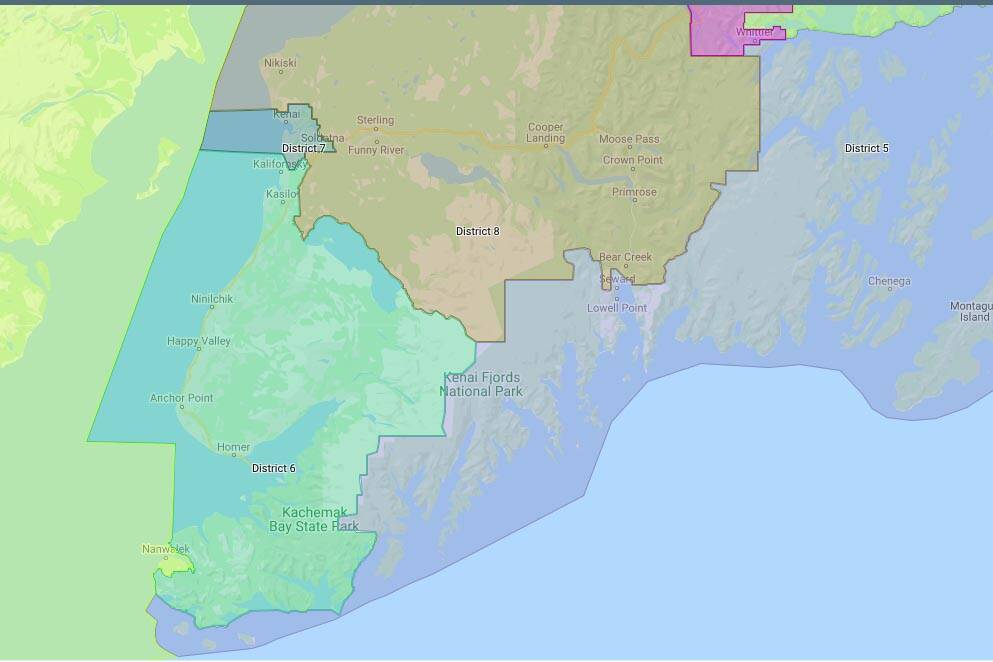Seward will vote with Kodiak, not Nikiski, under redistricting plans adopted by the Alaska Redistricting Board during a public hearing on Nov. 5. The monthslong redistricting process, which happens every 10 years following the census, is winding down following a statewide circuit conducted by the board to gather feedback on proposed plans.
The southern boundary of the district that is currently represented by Republican Rep. Ben Carpenter was expanded, from the northern rim of Skilak Lake to the northern rim of Tustumena Lake. Carpenter’s district used to include Seward and Lowell Point, which now fall in the same district as Kodiak and Cordova, currently represented by Speaker of the House Louise Stutes, a Republican.
Carpenter’s district now abruptly swerves to include a chunk of land across Resurrection River west of Seward, before swerving back to cut off Seward and Bear Creek where the highway crosses the river. The new boundaries put Seward in the same district as other Gulf Coast communities, represented by Stutes, and places Bear Creek in the same district as Nikiski, represented by Carpenter.
The district containing Kenai and Soldotna, currently represented by Republican Rep. Ron Gillham in the State House, now no longer includes some residents in the Mackey Lake area. Maps adopted in 2013 show the eastern boundary of that district running along Mackey Lake Road almost to the Sterling Highway. The new maps step down twice between Sports Lake Road and Riggs Avenue, carving around businesses like the Loon Lake Resort and King’s Haven Lodge — which are now in Carpenter’s district.
Further south, communities across Kachemak Bay will now vote with Homer and other southern peninsula communities instead of with Kodiak and Tyonek. That’s with the exception of Nanwalek, which will continue to vote with communities across Cook Inlet.
In all, the board approved six plans for consideration, none of which were expected to be the final version. Central peninsula residents testified in support of keeping communities together at an open house the redistricting board held in Soldotna in October. Many opposed a map that would have put Nikiski and south Anchorage in the same district, as well as a map that would have broken off a chunk of the City of Kenai.
Alaska Redistricting Board member Nicole Borromeo said during October’s open house that the Kenai Peninsula’s population grew by about 6.9% between 2010 and 2020, second only to the Matanuska-Susitna Borough, which she said the board was “wrestling with.”
Criteria for drawing state legislative districts is outlined in the Alaska Constitution, which says that districts must be contiguous and compact in addition to being equal in population size with socioeconomic integration. Legal explanations and definitions for each of those phrases have been fleshed out by the Alaska Supreme Court in cases heard between 1972 and 2012.
Alaska had a population of about 733,391 according to the 2020 census. Alaska’s constitution describes 40 legislative districts, meaning that each district should be drawn such that it contains as close to 18,335 people as possible.
The Alaska Redistricting Board reconvened Monday to consider, among other things, Senate pairings with the newly approved House districts, according to the agenda for that meeting. A final map must be adopted by Nov. 10.
An interactive map of new State House district boundaries can be found on the Alaska Redistricting Board’s website at akredistrict.org.
Reach reporter Ashlyn O’Hara at ashlyn.ohara@peninsulaclarion.com.

